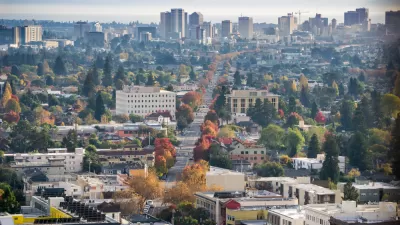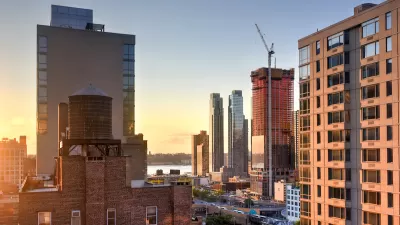NYT reporter Amy O'Leary observes Manhattan's ubiquitous construction while suffering through overcrowded sidewalks, stores, and subway trains, and wonders just how many more people the crowded borough can absorb.
O'Leary provides a historical basis just in case the reader thinks the crowds are intolerable now. She reports that Manhattan had been much more crowded in 1910 when a "staggering 2.3 million people crowded the borough, mostly in tenement buildings. It was a time before zoning, when roughly 90,000 windowless rooms were available for rent..."
Then came "1980, with the subsequent flight to suburbia, the population fell to 1.4 million." The 2010 population is 1.586 million.
Sky's the limit.
Most interesting is the perspective of "Ed Glaeser, a Harvard economist, (who) inevitably comes up in conversations about how cities should grow. In his recent book, "Triumph of the City," he makes an argument - which many consider persuasive - that dense places are uniformly better and more interesting than emptier ones, and that they should be allowed to develop unfettered, even if it means building towers where brownstones once stood."
"Affordability is the first reason. If you build up, he says, housing prices will fall and more people will be able to live in their own sliver of Manhattan sky. And that's a good thing, Mr. Glaeser adds, since the energy of all those newcomers will fuel innovation and entrepreneurship, attracting talent and growth to create a virtuous circle. From energy-efficiency to life expectancy to finding a date or something to do on a Saturday night, Mr. Glaeser argues that denser places have the edge."
Thanks to Mark Boshnack
FULL STORY: Everybody Inhale: How Many People Can Manhattan Hold?

Planetizen Federal Action Tracker
A weekly monitor of how Trump’s orders and actions are impacting planners and planning in America.

Restaurant Patios Were a Pandemic Win — Why Were They so Hard to Keep?
Social distancing requirements and changes in travel patterns prompted cities to pilot new uses for street and sidewalk space. Then it got complicated.

Map: Where Senate Republicans Want to Sell Your Public Lands
For public land advocates, the Senate Republicans’ proposal to sell millions of acres of public land in the West is “the biggest fight of their careers.”

Maui's Vacation Rental Debate Turns Ugly
Verbal attacks, misinformation campaigns and fistfights plague a high-stakes debate to convert thousands of vacation rentals into long-term housing.

San Francisco Suspends Traffic Calming Amidst Record Deaths
Citing “a challenging fiscal landscape,” the city will cease the program on the heels of 42 traffic deaths, including 24 pedestrians.

California Homeless Arrests, Citations Spike After Ruling
An investigation reveals that anti-homeless actions increased up to 500% after Grants Pass v. Johnson — even in cities claiming no policy change.
Urban Design for Planners 1: Software Tools
This six-course series explores essential urban design concepts using open source software and equips planners with the tools they need to participate fully in the urban design process.
Planning for Universal Design
Learn the tools for implementing Universal Design in planning regulations.
Heyer Gruel & Associates PA
JM Goldson LLC
Custer County Colorado
City of Camden Redevelopment Agency
City of Astoria
Transportation Research & Education Center (TREC) at Portland State University
Camden Redevelopment Agency
City of Claremont
Municipality of Princeton (NJ)





























